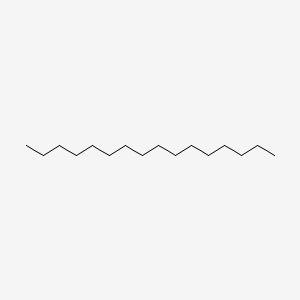| MeSH term | MeSH ID | Detail |
|---|---|---|
| Lupus Erythematosus, Systemic | D008180 | 43 associated lipids |
| Body Weight | D001835 | 333 associated lipids |
| Coronary Disease | D003327 | 70 associated lipids |
| Peritonitis | D010538 | 38 associated lipids |
| Hyperplasia | D006965 | 34 associated lipids |
| Glomerulonephritis | D005921 | 35 associated lipids |
| Encephalomyelitis, Autoimmune, Experimental | D004681 | 26 associated lipids |
| Keratosis | D007642 | 9 associated lipids |
| Serratia Infections | D016868 | 2 associated lipids |
Hexadecane
Hexadecane is a lipid of Fatty Acyls (FA) class. The involved functions are known as Analyte. The related lipids are Fatty Acids and palmitoleic acid.
Cross Reference
Introduction
To understand associated biological information of Hexadecane, we collected biological information of abnormalities, associated pathways, cellular/molecular locations, biological functions, related genes/proteins, lipids and common seen animal/experimental models with organized paragraphs from literatures.
What diseases are associated with Hexadecane?
There are no associated biomedical information in the current reference collection.
Possible diseases from mapped MeSH terms on references
We collected disease MeSH terms mapped to the references associated with Hexadecane
PubChem Associated disorders and diseases
What pathways are associated with Hexadecane
There are no associated biomedical information in the current reference collection.
PubChem Biomolecular Interactions and Pathways
Link to PubChem Biomolecular Interactions and PathwaysWhat cellular locations are associated with Hexadecane?
There are no associated biomedical information in the current reference collection.
What functions are associated with Hexadecane?
Related references are published most in these journals:
| Function | Cross reference | Weighted score | Related literatures |
|---|
What lipids are associated with Hexadecane?
Related references are published most in these journals:
| Lipid concept | Cross reference | Weighted score | Related literatures |
|---|
What genes are associated with Hexadecane?
There are no associated biomedical information in the current reference collection.
What common seen animal models are associated with Hexadecane?
There are no associated biomedical information in the current reference collection.
NCBI Entrez Crosslinks
All references with Hexadecane
Download all related citations| Authors | Title | Published | Journal | PubMed Link |
|---|---|---|---|---|
| Zhou X et al. | Quantitative proteomics analysis of proteins involved in alkane uptake comparing the profiling of Pseudomonas aeruginosa SJTD-1 in response to n-octadecane and n-hexadecane. | 2017 | PLoS ONE | pmid:28662172 |
| Ng CH and Yang KL | Lipase in biphasic alginate beads as a biocatalyst for esterification of butyric acid and butanol in aqueous media. | 2016 | Enzyme Microb. Technol. | pmid:26672465 |
| Herath A et al. | Transcriptional response of Desulfatibacillum alkenivorans AK-01 to growth on alkanes: insights from RT-qPCR and microarray analyses. | 2016 | FEMS Microbiol. Ecol. | pmid:27009900 |
| Taylor GJ et al. | Direct in situ measurement of specific capacitance, monolayer tension, and bilayer tension in a droplet interface bilayer. | 2015 | Soft Matter | pmid:26289743 |
| Czekalska MA et al. | A droplet microfluidic system for sequential generation of lipid bilayers and transmembrane electrical recordings. | 2015 | Lab Chip | pmid:25412368 |
| Madej BD et al. | A Parameterization of Cholesterol for Mixed Lipid Bilayer Simulation within the Amber Lipid14 Force Field. | 2015 | J Phys Chem B | pmid:26359797 |
| Pirog TP et al. | [Synthesis of surfactants by Rhodococcus erythropolis IMV Ac-5017, Acinetobacter calcoaceticus IMV B-7241 and Nocardia vaccinii IMV B-7405 on industrial waste]. | 2014 Mar-Apr | Mikrobiol. Z. | pmid:25000725 |
| Béchohra I et al. | Biodegradation of toluene in a two-phase partitioning bioreactor--impact of activated sludge acclimation. | 2014 Mar-Apr | Environ Technol | pmid:24645454 |
| Pirog TP et al. | [Influence of heavy metals on surfactants synthesis by Nocardia vaccinii IMV B-7405]. | 2014 Jul-Aug | Mikrobiol. Z. | pmid:25199340 |
| Watanabe T et al. | Microfluidic approach to the formation of internally porous polymer particles by solvent extraction. | 2014 | Langmuir | pmid:24568261 |
